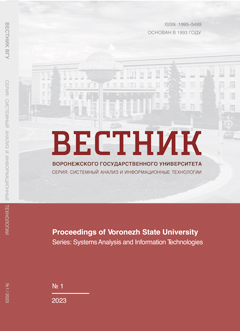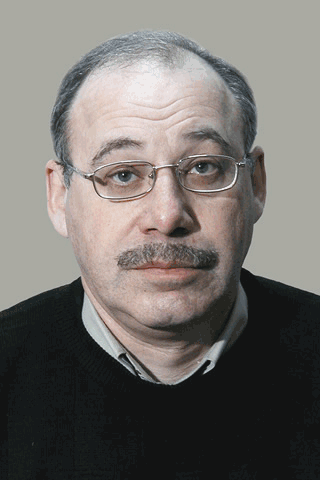Алгоритм клеточно-автоматного моделирования 2D эволюции бактериальных пленок в процессе непрерывного культивирования
Аннотация
В работе предложен и программно реализован алгоритм работы клеточного автомата, предназначенного для моделирования поверхностного роста бактериальной пленки в условиях проточного культивирования. Для построения решетки клеточного автомата использованы гексагональные ячейки. Этот подход, несмотря на увеличенную сложность реализации, позволяет улучшить адекватность результатов моделирования по сравнению с реализацией на основе классической ортогональной сетки, ввиду большего числа внутренних связей. В основе работы алгоритма лежат механизмы многофазной популяционной динамики бактериальных колоний: инициация (интерфаза), рост пленки за счет активного деления. Система имитационного моделирования реализована в платформе Unity на языке C#. Программная реализация была дополнена процедурой интервальной оценки фрактальной размерности визуализируемых структур биопленок. Данные компьютерного моделирования качественно соответствуют результатам биологического эксперимента по исследованию популяционной динамики бактерий.
Скачивания
Литература
2. Mardanova A. M. [et al.] (2016) Biofilms: basic research methods: educational and methodical manual; edited by O.N. Kazan: K(P)FU. 42 p.
3. Tuon F. F., Dantas L. R., Suss P. H., Ribeiro V. S. T. (2022) Pathogenesis of the Pseudomonas aeruginosa Biofilm: A Review. Pathogens. 11. P. 300–319.
4. De Kievit T. R. (2009) Quorum sensing in Pseudomonas aeruginosa biofilms. Environ Microbiol. 11(2). P. 279–288.
5. Yan S., Wu G. (2019) Can biofilm be reversed through quorum sensing in Pseudomonas aeruginosa? Front. Microbiol. 10. P. 1582–1589.
6. Duddu R., Bordas S., Chopp D., Moran B. (2008) A combined extended finite element and level set method for biofilm growth. International Journal for Numerical Methods in Engineering. 74. P. 848–870.
7. Loosdrecht M. C. M., Heijnen J. J., Eberl H., Kreft J., Piciorenau C. (2002) Mathematical modelling of biofilm structures. Antonie van Leeuwenhoek. 81. P. 245–256.
8. Rida S. Z., El-Sayed A. M., Arafa A. A. M. (2010) Effect of bacterial memory dependent growth by using fractional derivatives reaction-diffusion chemotactic model. Journal of Statistical Physics. 140. P. 797–811.
9. Bazhlekov I., Bazhlekova E. (2022) Fractional derivative modeling of bioreaction-diffusion processes. AIP Publishing. DOI
10. Aenne C. O. (2017) Mathematical modeling and pattern formation for bacterial colonies: diss. PhD thesis. Technische Universität München.
11. Kawasaki K., Mochizuki A., Matusushita M., Umeda T., Shigesada N. (1997) Modeling spatio-temporal patterns generated by Bacillus subtilis. Journal of Theoretical Biology. 188. P. 177–185.
12. Vitvitsky A. A. (2014) Cellular automata with a dynamic structure for modeling the growth of biological tissues. Sibirsky Journal of Computational Mathematics. Vol. 17. P. 315–327.
13. Medvedev Yu. G. (2010) Modeling of piston motion in a gas medium by a cellular automaton. Applied discrete Mathematics. No 4 (10). P. 103–108.
14. Fedoseeva L. I. (2013) Fundamentals of the theory of cellular automata and formal languages. Penza : Penza State Technological University. 141 p.
15. Bandman O. L. (2005) Cellular automaton models of spatial dynamics. System Informatics. Issue 10. P. 57–113.
16. Kuznetsov A. V. (2017) Generation of a random landscape by given configuration entropy and total edge. Computational technologies. 22(4). P. 4–10.
17. Batyrgazieva D. R. (2021) Information and analytical complex in the field of prebiotics and mammalian cell culture processes. Moscow : D. I. Mendeleev Russian University of Chemical Technology. P. 110–112.
18. Zubairova U. S., Panchenko A.V. and Nikolaev S. V. (2012) Modeling of growth and development of plant tissues in the formalism of L-systems. Vavilovsky Journal of Genetics and Breeding. Vol. 16. No 4/1. P. 816–824.
19. Nikolaev S. V. [et al.] (2010) The study of a one-dimensional model of regulation of the size of the renewal zone in biological tissue taking into account cell division. Siberian Journal of Industrial Mathematics. Vol. 13, No 4. – P. 70–82.
20. Picioreanu С., van Loosdrecht M.C.M., Heijnen J. J. (1998) A new combined differential-discrete cellular automaton approach for biofilm modeling: application for growth in gel beads. Biotechnol Bioeng. 57(6). P. 718–731.
21. Picioreanu С., Kreft J. U., van Loosdrecht M.C.M. (2004) Particle-based multidimensional multispecies biofilm model. Applied and Environmental Microbiolog. 70(5). P. 3024–3064.
22. Rodriguez D., Einarsson B., Carpio A. (2012) Biofilm growth on rugose surfaces. Physical review. E, Statistical, nonlinear, and soft matter physics. 86 (6). 061914 (16).
23. Rodriguez D., Carpio A., Einarsson B. (2014) A cellular automata model for biofilm growth. 10th World Congress on Computational Mechanics, Blucher Mechanical Engineering Proceedings. 1. P. 409–421.
24. Kuttler C., Maslovskaya A. (2022) Computer-assisted modelling of quorum sensing in bacterial population exposed to antibiotics. Frontiers in Applied Math and Statistics. DOI
25. Kuttler C., Maslovskaya A. (2021) Hybrid stochastic fractional-based approach to modeling bacterial quorum sensing. Applied Mathematical Modelling. 93. P. 360–375.
26. Shuai I., Khmelev A. P. and Maslovskaya A. G. (2021) Reaction-diffusion model of bacterial communication taking into account variations of the law of population growth. Bulletin of the AmSU, series «Natural and Economic Sciences». Issue 93. P. 14–23.
27. Sarukhanyan S. K. and Maslovskaya A. G. (2022) The simplest cellular automaton for modeling the surface growth of bacteria. Bulletin of the AmSU, series «Natural and Economic Sciences». Issue 99. P. 7–12.
28. Bozhokin S. V. and Parshin D. A. (2001) Fractals and multifractals. Izhevsk : SIC «Regular and chaotic dynamics». 128 p.
29. Ditmarsch D., Xavier J. B. (2011) High-resolution time series of Pseudomonas aeruginosa gene expression and rhamnolipid secretion through growth curve. BMC Microbiology. 11.140 (10)
- Авторы сохраняют за собой авторские права и предоставляют журналу право первой публикации работы, которая по истечении 6 месяцев после публикации автоматически лицензируется на условиях Creative Commons Attribution License , которая позволяет другим распространять данную работу с обязательным сохранением ссылок на авторов оригинальной работы и оригинальную публикацию в этом журнале.
- Авторы имеют право размещать их работу в сети Интернет (например в институтском хранилище или персональном сайте) до и во время процесса рассмотрения ее данным журналом, так как это может привести к продуктивному обсуждению и большему количеству ссылок на данную работу (См. The Effect of Open Access).



















